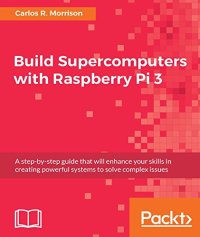
Ebook: Build Supercomputers with Raspberry Pi 3
Author: Carlos R. Morrison
- Tags: Mainframes & Minicomputers, Hardware & DIY, Computers & Technology, Microprocessors & System Design, Computer Design, Control Systems, DSPs, Embedded Systems, Microprocessor Design, PIC Microcontroller, Hardware & DIY, Computers & Technology, Single Board Computers, Hardware & DIY, Computers & Technology, Mainframes & Minicomputers, Hardware, Computers & Technology, Categories, Kindle Store
- Year: 2017
- Publisher: Packt Publishing
- Edition: 1
- Language: English
- azw3
Key Features
- Carlos R. Morrison from NASA will teach you to build a supercomputer with Raspberry Pi 3
- Deepen your understanding of setting up host nodes, configuring networks, and automating mountable drives
- Learn various math, physics, and engineering applications to solve complex problems
Book Description
Author Carlos R. Morrison (Staff Scientist, NASA) will empower the uninitiated reader to quickly assemble and operate a Pi3 supercomputer in the shortest possible time. The lifeblood of a supercomputer, the MPI code, is introduced early, and sample MPI code provides additional practice opportunities for you to test the effectiveness of your creation. You will learn how to configure various nodes and switches so that they can effectively communicate with each other. By the end of this book, you will have successfully built a supercomputer and the various applications related to it.
What you will learn
- Understand the concept of the Message Passing Interface (MPI)
- Understand node networking.
- Configure nodes so that they can communicate with each other via the network switch
- Build a Raspberry Pi3 supercomputer.
- Test the supercluster
- Use the supercomputer to calculate MPI p codes.
- Learn various practical supercomputer applications
About the Author
Carlos R. Morrison was born in Kingston, Jamaica, West Indies. He received a B.S. (Hons) degree in physics with a mathematics minor in 1986 from Hofstra University, Hempstead, NY, and an M.S. degree in physics in 1989 from Polytechnic University, Brooklyn, NY.
In 1989, he joined the NASA Glenn Research Center, Cleveland, OH, as a staff scientist in the solid-state physics branch and, in 1999, he transferred to the structures and dynamics branch. He has authored and coauthored several journal and technical articles associated with aerospace and electromagnetic devices. He holds several patents, including one on the Morrison Motor for which he won the 2004 R&D 100 Award, and software technologies used to control magnetic bearings. He is currently engaged in research associated with room temperature and superconducting reluctance motors, and Simulink Simulation of said motors.
Mr. Morrison is a member of the American Physical Society and the National Technical Association.
Table of Contents
- Getting Started with Supercomputing
- One Node Supercomputing
- Preparing the Initial Two Nodes
- Static IP Address and Hosts File Setup
- Creating a Common User for All Nodes
- Creating a Mountable Drive on the Master Node
- Configuring the Eight Nodes
- Testing the Super Cluster
- Real-World Math Application
- Real-World Physics Application
- Real-World Engineering Application
- Appendix